As a part of a seminar series hosted by Tech’s Center for Robotics and Intelligent Machines (RIM), representatives from the ocean data services provider Liquid Robotics spoke about their Wave Glider technology, the first wave-powered autonomous vehicle of its kind. Liquid Robotics is looking to hire students with the initiative and interest to help build an ocean infrastructure for collecting data.
The marine robots harness energy from currents in the ocean, taking no fuel—they are instead powered by solar panels. A submarine section underneath uses the ebb and flow of powerful surface wave motion to thrust the Wave Glider forward on a series of articulated wings.
“The Wave Glider technology effectively lowers the barriers to doing ocean research. It can be both expensive and dangerous to send out manned crews out on the open ocean for extended periods of time, especially for when it comes to ocean data collection that has to be done far away from the shore,” said Dan Moroni, Project Strategist at Liquid Robotics.
As well as being economical and ecologically sound, Wave Gliders are also able to deliver immediate feedback to their pilots.
Equipped with GPS for navigation, communication capability with satellites, and sensors for data collection, sensors on the Wave Glider can be used to monitor everything from the presence of oil and algae to real-time seismic activity for the many companies they have partnered with, such as Schlumberger Oil & Gas and Chevron.
“We have sensors on the ocean floor collecting seismic data, and we can go out every six months to get and study that data, but what good is that if you’re not getting it in real-time? Our Wave Glider can sit above seismic centers and deliver the data as it’s gathered,” Moroni said.
Operating out of Sunnyvale, Calif., Liquid Robotics developed the Wave Glider within two years of the company’s foundation in 2007. They have deployed roughly 150 Wave Gliders so far, and at any given moment there are about 40 of them floating out on ocean currents around the world.
The marine vehicles can endure out on the ocean for up to a year at a time without needing to be refueled or reconfigured. Threats to the Wave Gliders’ longevity on missions include encrusters like barnacles, which attempt to turn the vehicles into a habitable zone.
Wave Gliders have come a long way since they completed their first long-distance endurance test in Jan. 2009, circumnavigating Hawaii’s Big Island. In Nov. 2011, Liquid Robotics deployed four Wave Gliders on a mission that would span involve a 9,000 nautical-mile journey from the coast of San Francisco.
Along the way, they battled storms and sharks, relaying high-resolution oceanographic and atmospheric data until one of the vehicles, “Papa Mau,” landed in Australia after a year’s time and became the first autonomous vehicle to cross the Pacific.
Integration is an essential part of Liquid Robotics’ projects. They want the Wave Glider to be a foundation upon which other researchers from a cross-disciplinary approach—from software engineering, electrical, mechanical and ocean science fields—can apply the platform and expand on it.
“We’ve created a thriving academic program, hosting seminars all over the world with institutions’ oceanautics departments and other fields. We talk to them about what we do and how we can fit in, the projects that they are working on and how we can benefit from each other’s work. We want to get the Wave Glider technology out to as many different people as we can,” said Amy Rubsamen, Liquid Robotics’ Academic Liaison and Sales Manager.
One of the greatest drives of the Wave Glider technology is to encourage problem-solving in areas where the turbulent environment and challenges presented by ocean climate affect human activities in ways that are not entirely understood. Measuring the different factors that are involved with this environment is a vital function of the platform itself.
“The ocean is extremely important to global society…but much of it is also uncharted territory that often corresponds with issues that need addressing like climate change and seismic activity that can have a big impact on how we live,” Moroni said.
Liquid Robotics is currently considering the “larger than life” problems that they believe the cutting edge technology of Wave Gliders can help to address through the potential of future collaboration.
“It’s upsetting that we don’t know very much about our oceans, and I’m hoping that our platform will make them more accessible to people from converging fields who want to use the technology for finding solutions to major problems,” Moroni said.
